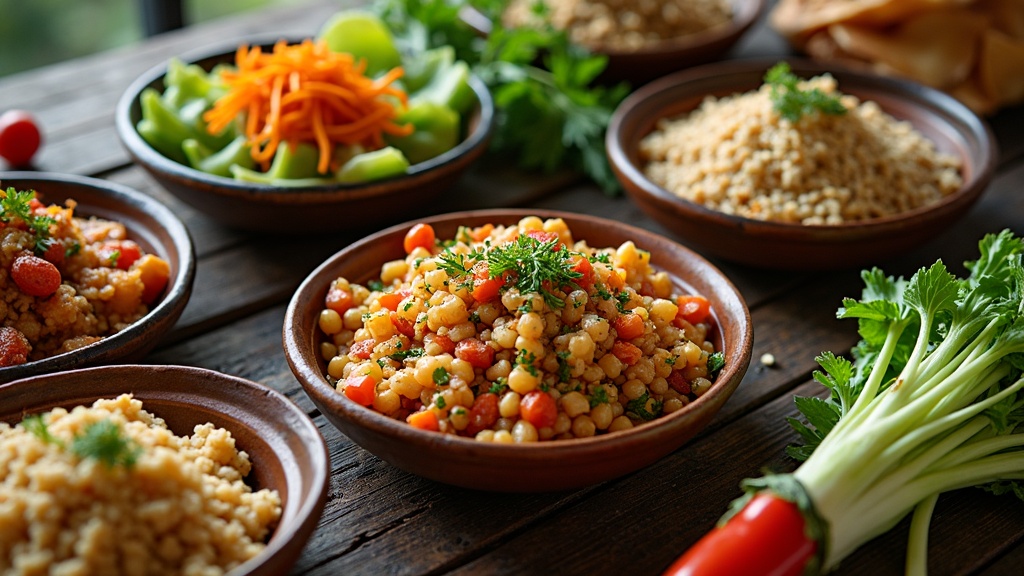Checking out how plantbased diets are researched and experienced across different cultures can be eyeopening.
Each region brings its own flavors, traditions, and perspectives to eating mostly from plants.
Understanding these differences gives us more tools for making food choices that fit both personal values and lifestyle.
I’ve pulled together what I’ve learned about plantbased diets in global contexts, the latest research, and how to approach plantforward eating no matter where you’re from.

How Plantbased Diets Show Up Around the World
Plantbased eating isn’t just a trend; it’s a lifestyle that has been part of many cultures for centuries.
Some regions treat plantbased diets as the regular way to eat, while others have seen a switch up toward this style in recent years.
For example, traditional diets in Asia often include plenty of grains, vegetables, and legumes.
Think of Indian cuisine, where vegetarian curries and lentil dishes are everywhere.
In Japan, staples like tofu and seaweed bring protein and nutrients from plants.
The Mediterranean diet, super popular for its health perks, is packed with vegetables, beans, nuts, and olive oil, even if it sometimes includes fish or dairy.
Meanwhile, in parts of Africa and Latin America, plantforward meals are just daily life; beans, rice, root vegetables, and leafy greens fill plates regularly.
In Western countries, plantbased diets have gained momentum more recently, especially as people look for alternatives to processed foods and seek out new ways of eating that are lighter on the environment.
Current Research on Plantbased Diets in Different Cultures
Studies show that plantbased diets are linked with many health benefits like lower risks of heart disease, diabetes, and some cancers (source).
But how researchers study these diets varies by location.
In countries with longstanding vegetarian or largely plantbased populations, like India, China, and parts of Africa, scientists often compare plantbased eaters with those who eat more animal products.
In Western countries, researchers usually focus on the rise in veganism and vegetarianism as lifestyle choices.
Research coming out of the US, Canada, and Europe often connects plantbased eating to environmental impact, personal ethics, and chronic disease risk.
For instance, a study published in The Lancet points out that plantheavy diets can help lower greenhouse gas emissions and use less land (source).
In Asian countries, studies may look at the longterm effects of eating mostly rice, soy, and green veggies, while Africanbased research might look at the role of pulses, yams, and local grains.
These differences matter because genetics, environment, and even gut bacteria can influence how we react to and benefit from what we eat.
Researchers in Latin America are also exploring how traditional foodways can keep communities healthier by focusing on native grains and legumes.
It’s worth noting that cultural perceptions of healthful eating shape both research and everyday habits.
While many Western studies focus on replacing meat, studies in India or Japan sometimes dig into the spiritual, religious, or communal reasons behind diet patterns.
This perspective adds a unique layer to understanding how plantbased diets function not just as a health choice, but as a part of daily life and identity.
Getting Started: Embracing Plantbased Foods No Matter Where You’re From
Trying out a plantbased diet can feel easier when using familiar foods and recipes from your cultural background.
Food is all about comfort and connection, so adapting tradition is often a smart move.
Here are some terms and foods to get familiar with if you’re thinking about eating more plantbased meals:
- Legumes: Beans, lentils, and chickpeas are key proteins and work well in all sorts of dishes.
- Whole Grains: Brown rice, quinoa, millet, and oats can be found in many global cuisines.
- Plant Proteins: Tofu, tempeh, and seitan often come up in Asian and Western plantbased meals.
- Leafy Greens: Greens like spinach, collards, and bok choy offer a boost of vitamins and minerals.
- Traditional Spices & Flavors: Using spices, fresh herbs, and local ingredients makes meals familiar and interesting.
Don’t overlook root vegetables like sweet potatoes and taro or fermented plantbased foods such as kimchi, sauerkraut, and injera—these add both flavor and nutrition.
Including a mix of cooked and raw produce, plus nuts and seeds, provides balanced energy and a spectrum of nutrients.
Steps for Adopting a Plantbased Diet with Cultural Roots
Here’s how I’ve found plantbased eating works best when rooted in culture and tradition:
- Start with Familiar Dishes: Swap chicken for chickpeas or lentils in curries, stews, or tacos.
- Seek Out Local Plant Foods: Every region has its own greens, fruits, and grains that shine in plantbased recipes.
- Learn to Build Balanced Plates: Combining grains, legumes, and a variety of veggies keeps meals satisfying and nutritious.
- Use Seasonings from Home: Lean into the spices, sauces, and herbs you grew up with to keep things tasty.
- Share with Family or Friends: Cooking and eating together helps keep culture alive, even as the menu changes.
Adding rituals around mealtime or using traditional bowls and utensils can help maintain cultural connections.
Bringing together culture and nutrition helps make the adventure more enjoyable; often, family and friends are more willing to try new things when the flavors feel like home.
Common Challenges When Switching to a Plantbased Diet
Switching to a plantfocused diet doesn’t always go smoothly, especially if animal foods are central to family gatherings or traditions.
Here are a few bumps people run into, and how to move past them:
- Protein Worries: Not having enough protein is a common fear. Plantbased diets around the world have figured this out by using beans, lentils, nuts, and seeds.
- Getting the Right Nutrients: Iron, B12, and Omega3s can sometimes be tougher to get from plants alone. Fortified foods or supplements help bridge the gap.
- Social Pushback: Changing your diet can get reactions from family or friends who aren’t on board. Sharing delicious meals and explaining your reasons can help break down walls.
- Shopping and Cooking: Finding plantbased staples can be tricky in some areas. Exploring local markets for native beans, grains, and vegetables is pretty handy.
Protein Solutions
Adding foods like lentil soup common in Middle Eastern cuisine or Ethiopian split pea stews can keep protein high.
Even everyday foods like peanut butter, hummus, or tofu pack a good protein punch.
Don’t forget about nuts and seeds; sunflower seeds or almonds tossed over salads are simple protein boosters.
Staying NutrientSmart
Taking a vitamin B12 supplement and paying attention to iron sources helps, especially for anyone who eats mostly plants.
Some cultures naturally include ironrich foods like leafy greens or pumpkin seeds.
Cooking with ingredients like amaranth leaves or blackstrap molasses can add iron variety.
Pairing ironrich plants with vitamin C foods helps absorption, so adding citrus or tomatoes is a smart move.
Keeping the Social Side Positive
I find that inviting friends to taste a hearty plantbased chili or a classic dal removes some skepticism.
Over time, you might even see others joining in for Meatless Mondays or similar swaps.
Sharing new plantbased recipes at potlucks can introduce others to tasty options, making plantbased living feel welcoming rather than isolating.
Best Practices from Different Cultures
Here are practical lessons from parts of the world where plantbased eating is already a norm:
- India: Rely on lentils (dal), chickpeas (chana), rice, and spices. Indian thalis offer variety and balance.
- Middle East: Build meals from falafel, hummus, tabbouleh, and roasted veggies, all naturally plantcentered.
- Japan: Include soy foods, seaweed, rice, and pickled vegetables. A traditional Japanese breakfast is often packed with plant foods.
- Africa: Enjoy bean stews, cassava, and leafy greens, with flavor from peanut sauce or spices.
- Latin America: Mix black beans, corn, squash, and fresh salsas for a satisfying combo.
Adapting these dishes to use what’s accessible in your area adds flexibility and fun to plantbased living.
Additionally, connecting with local community gardens or food coops can make it easier to track down traditional plant ingredients.
Frequently Asked Questions
These are some questions friends and readers often ask when considering plantbased diets around the world:
Question: Will a plantbased diet fit traditional celebrations?
Answer:
Many classic dishes can be adjusted; try replacing meat with beans or mushrooms in stuffing, or using lentils in shepherd’s pie.
Small changes add up without losing the spirit of the meal.
Question: What about kids or older adults; can they thrive eating plantbased?
Answer:
With good planning, plantbased diets support all ages.
Beans, grains, nuts, and veggies cover key nutrients, and a B12 supplement covers what’s missing.
Question: Are there resources for finding plantbased recipes specific to my culture?
Answer:
Loads of cookbooks and bloggers focus on plantbased versions of traditional cuisine.
Checking out local vegetarian restaurants or community groups often inspires fresh ideas too.
Closing Thoughts
Learning about plantbased diets in different cultures opens up a world of flavor and variety.
Whether you’re new to eating mostly plants or you grew up with these foods, looking at how other cultures approach plantforward meals offers inspiration and reassurance that you’re not alone in the adventure.
Tuning in to tradition, nutrition, and community support helps keep things balanced and tasty.
Trying out new recipes, learning from global research, and staying flexible goes a long way when making plantbased eating part of daily life.
By bringing together what works across cultures and adding your own twist, plantbased meals can be both nourishing and deeply satisfying.
Keep exploring and tasting; you never know which new favorite dish you’ll stumble upon next.
